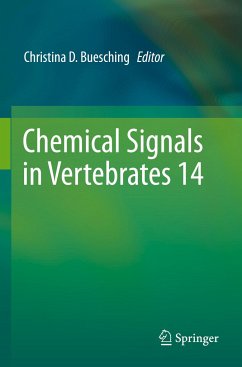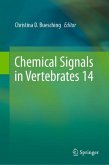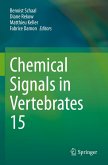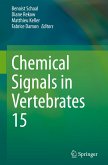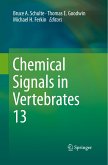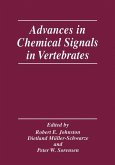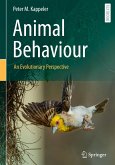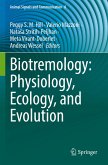Chemical Signals in Vertebrates 14
Herausgegeben:Buesching, Christina D.
Chemical Signals in Vertebrates 14
Herausgegeben:Buesching, Christina D.
- Broschiertes Buch
- Merkliste
- Auf die Merkliste
- Bewerten Bewerten
- Teilen
- Produkt teilen
- Produkterinnerung
- Produkterinnerung
In August 2017, the Chemical Signals in Vertebrates (CSiV) group held its 14th triennial meeting at Cardiff University in Wales. This well established international conference brings together leaders and students in the field of olfactory communication and chemical signaling of vertebrates to present new advances in their research as well as synopses of disparate areas under new angles. This volume is a collection of the proceedings of this meeting authored by leading experts in this field that covers a wide variety of topics in chemical ecology.
Andere Kunden interessierten sich auch für
![Chemical Signals in Vertebrates 14 Chemical Signals in Vertebrates 14]() Chemical Signals in Vertebrates 14112,99 €
Chemical Signals in Vertebrates 14112,99 €![Chemical Signals in Vertebrates 15 Chemical Signals in Vertebrates 15]() Chemical Signals in Vertebrates 15171,99 €
Chemical Signals in Vertebrates 15171,99 €![Chemical Signals in Vertebrates 15 Chemical Signals in Vertebrates 15]() Chemical Signals in Vertebrates 15171,99 €
Chemical Signals in Vertebrates 15171,99 €![Chemical Signals in Vertebrates 13 Chemical Signals in Vertebrates 13]() Chemical Signals in Vertebrates 13172,99 €
Chemical Signals in Vertebrates 13172,99 €![Advances in Chemical Signals in Vertebrates Advances in Chemical Signals in Vertebrates]() Advances in Chemical Signals in Vertebrates150,99 €
Advances in Chemical Signals in Vertebrates150,99 €![Animal Behaviour Animal Behaviour]() Peter M KappelerAnimal Behaviour65,99 €
Peter M KappelerAnimal Behaviour65,99 €![Biotremology: Physiology, Ecology, and Evolution Biotremology: Physiology, Ecology, and Evolution]() Biotremology: Physiology, Ecology, and Evolution171,99 €
Biotremology: Physiology, Ecology, and Evolution171,99 €-
-
-
In August 2017, the Chemical Signals in Vertebrates (CSiV) group held its 14th triennial meeting at Cardiff University in Wales. This well established international conference brings together leaders and students in the field of olfactory communication and chemical signaling of vertebrates to present new advances in their research as well as synopses of disparate areas under new angles. This volume is a collection of the proceedings of this meeting authored by leading experts in this field that covers a wide variety of topics in chemical ecology.
Produktdetails
- Produktdetails
- Verlag: Springer / Springer International Publishing / Springer, Berlin
- Artikelnr. des Verlages: 978-3-030-17618-1
- 1st edition 2019
- Seitenzahl: 276
- Erscheinungstermin: 14. August 2020
- Englisch
- Abmessung: 235mm x 155mm x 16mm
- Gewicht: 423g
- ISBN-13: 9783030176181
- ISBN-10: 3030176185
- Artikelnr.: 59741405
- Herstellerkennzeichnung Die Herstellerinformationen sind derzeit nicht verfügbar.
- Verlag: Springer / Springer International Publishing / Springer, Berlin
- Artikelnr. des Verlages: 978-3-030-17618-1
- 1st edition 2019
- Seitenzahl: 276
- Erscheinungstermin: 14. August 2020
- Englisch
- Abmessung: 235mm x 155mm x 16mm
- Gewicht: 423g
- ISBN-13: 9783030176181
- ISBN-10: 3030176185
- Artikelnr.: 59741405
- Herstellerkennzeichnung Die Herstellerinformationen sind derzeit nicht verfügbar.
Dr. Christina D. Buesching is a Zoology Research Fellow with Oxford University's Wildlife Conservation Research Unit and is passionate about animal welfare and conservation. She did her MSc thesis on the reproductive behavior and physiology of Lesser Mouse Lemurs at the German Primate Centre and her DPhil on olfactory communication in European badgers at the University of Oxford. Since, she published over 100 scientific papers on a diverse range of ecological paradigms. Her main research interest, however, remains the role of semio-chemistry in animal reproductive behavior, where she focuses predominantly on the European badger as a model species.
1. Perspectives on chemical signals conveying information in rodents.- 2. Latrines as potential communication centres in short-beaked echidnas.- 3. Do urinary volatiles carry communicative messages in Himalayan Snow leopards [Panthera uncia, (Schreber, 1775)]?.- 4. Encoded information within urine influences behavioural responses among European badgers (Meles meles).- 5. LPS-induced immune system stimulation alters urinary volatiles and behaviour in growing pigs.- 6. A field study of wild echidna responses to conspecific odour.- 7. How diet affects vertebrate semiochemistry.- 8. The social function of latrines: A hypothesis-driven research approach.- 9. The effects of artificial fragrances on human olfactory communication.- 10. The human mammary odour factor: Variability and regularities in sources and functions.- 11. Cross-cultural approaches to better understand chemical communication in humans.- 12. Adaptation of the University of Pennsylvania Smell Identification Test for the population of Central Russia.- 13. House Mouse (Mus musculus) Avoidance of Olfactory Cues from Ferrets and Other Mammalian and Reptilian Predators: Preliminary Results.- 14. Do carnivores have a world wide web of interspecific scent signals?.- 15. Chemistry between salamanders: Evolution of the SPF courtship pheromone system in Salamandridae.- 16. Comparative structural modelling of bovine vomeronasal type-1 receptor I (VN1R1) and elucidation of molecular interactions with pheromones using in silico approaches.- 17. Detecting the smell of disease and injury: scoping evolutionary and ecological implications.
1. Perspectives on chemical signals conveying information in rodents.- 2. Latrines as potential communication centres in short-beaked echidnas.- 3. Do urinary volatiles carry communicative messages in Himalayan Snow leopards [Panthera uncia, (Schreber, 1775)]?.- 4. Encoded information within urine influences behavioural responses among European badgers (Meles meles).- 5. LPS-induced immune system stimulation alters urinary volatiles and behaviour in growing pigs.- 6. A field study of wild echidna responses to conspecific odour.- 7. How diet affects vertebrate semiochemistry.- 8. The social function of latrines: A hypothesis-driven research approach.- 9. The effects of artificial fragrances on human olfactory communication.- 10. The human mammary odour factor: Variability and regularities in sources and functions.- 11. Cross-cultural approaches to better understand chemical communication in humans.- 12. Adaptation of the University of Pennsylvania Smell Identification Test for the population of Central Russia.- 13. House Mouse (Mus musculus) Avoidance of Olfactory Cues from Ferrets and Other Mammalian and Reptilian Predators: Preliminary Results.- 14. Do carnivores have a world wide web of interspecific scent signals?.- 15. Chemistry between salamanders: Evolution of the SPF courtship pheromone system in Salamandridae.- 16. Comparative structural modelling of bovine vomeronasal type-1 receptor I (VN1R1) and elucidation of molecular interactions with pheromones using in silico approaches.- 17. Detecting the smell of disease and injury: scoping evolutionary and ecological implications.

